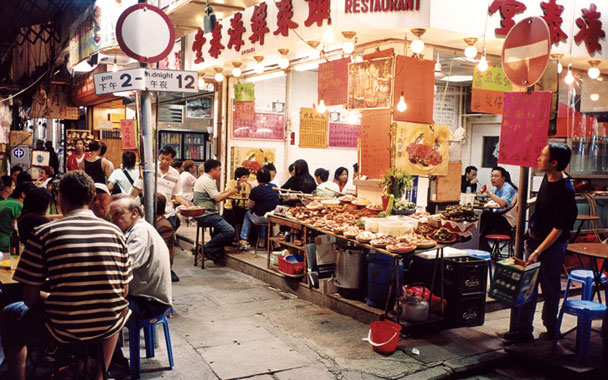On the morning of my second class, as I was washing the day’s first sinkful of dishes, Martha Sherpa told me that I shouldn’t be there. “I don’t think you ought to be making dim sum,” she said. I was elbow-deep in suds, and it hurt to hear this criticism of my clumsy hands and wooden fingers, which had apparently been lamely squeezing and pleating these delicate dumplings into travesties. But it turned out that wasn’t what she meant. She had been thinking about the questions I’d asked during our first class, questions that told her I was more interested in the foundational techniques of the Chinese kitchen—the proper way to stir-fry, to handle the cleaver, to marinate meat. She suggested trading one of my dim-sum sessions for a basic-skills class, one of dozens she offers in her tidy little four-wok school in Mongkok, the busiest neighborhood in Hong Kong. Eager to learn those skills, and excited by the realization that I was in the right place, I agreed.
Most cooking-school instructors are chefs. Martha Sherpa is a teacher, the kind that listens to students, that wants to find out what they want to learn and why, the kind that guides and challenges.
There she was, admonishing me to push harder on the daikon as I was slicing it, sideways, with the cleaver. It was taking too long, mainly because I wasn’t looking forward to hewing my palm off. So she demonstrated the cut again, peeling off transparent slices, and then stood there, waiting for me to do it myself, her silence a gentle challenge, her patience a show of support. That’s how she works—one-on-one with students—even if they come in groups. And it is why, I suspect, she turns down offers to appear on TV. In a previous class, as I pulled out a steamer full of halfway-decent dim sum, another student introduced himself as a chef from the Philippines and asked if he could document our efforts for his TV show. She invited him to take pictures of the food, if they would help him learn. “I mean,” he started over, “can I take pictures of you two, as teacher and student?” She invited him again to take pictures of the food.
This is not the place to go for a nice glass of wine and an entertaining demo. Martha was offered the chance to teach in one of those schools but turned it down because, as she put it, “all they want to show you is how big their flames are.” Here, with a big plastic pitcher of tea for refreshment, you cook from beginning to end. You cut everything yourself, you dig your hands into bowls filled with meat, you wash dishes. You concentrate so much on the turnip you’re slicing that you don’t have time to notice there’s not a drop of Chardonnay in sight. (011-852-2381-0132; cookery.com.hk; from $200 a day, with lunch)
What I Learned
You can fry—beautifully, greaselessly—by dumping cold oil on hot food. And that’s a lesson, because even the most experienced Western cook can have his world turned upside down by techniques that are so different from everything he’s ever learned.
Biggest Surprise
A thoughtful, responsive teacher is worth more than any amount of fancy equipment.
Before You Go
Take the time to read the course descriptions carefully and think about why you’re choosing your particular class; if you tell Martha what you want—to impress the neighbors, open a restaurant—she will tailor the instruction to your needs.
Where to Stay
Langham Place (011-852-3552-3388; langhamplacehotels.com; from $260). If you count the elevator ride, it’s a six-minute walk from the school to the hot tub in the spa on the 41st floor. Why should washing dishes be the only time you spend in hot water?




 Pinterest
Pinterest






